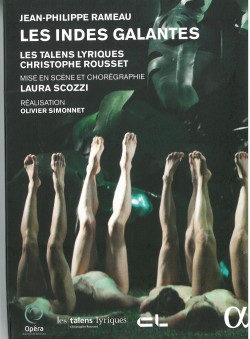 Rameau – Les Indes galantes
Rameau – Les Indes galantes
Les Talens Lyriques; Christophe Rousset
Alpha 710
It has always surprised me that, whereas musicians are concerned with the use of baroque performance practices in their realizations of 18th-century music, so few directors are interested in the use of baroque stage conventions. Of the operas I have seen, those directed by Gilbert Blin at the Boston Early Music Festival provide the only exceptions. In this production of Rameau’s Les Indes galantes, it is always clear that this is a modern conception by the director, Laura Scozzi. The opera opens with Hébé, the goddess of youth, dressed in a very revealing slip. She is joined by a troupe of nude dancers who give physical expression to their sense of joy. But on two occasions, an apple is tasted, a not too subtle warning that the fall is imminent. The fall arrives when Bellone, the goddess of war (the part is scored for a baritone) arrives on an all-terrain motorized vehicle. He is followed by a motley crew of ecclesiastics and men in football shirts. The male dancers are then given chainsaws and they move away. The main scenes in Rameau’s opera present us with exotic worlds: Turkey, Peru, Persia, America. In this production we see these worlds in terms of modern tourism in which faraway countries are linked through air travel. At the very end of the opera the dancers return and they are now joined by a very pregnant woman, also nude. Is there a suggestion here that we have moved beyond experience to a higher innocence?
Christophe Rousset conducts with real bite, unlike William Christie, stylish but sedate, in the earlier CD (Harmonia Mundi), in which Rousset played the harpsichord continuo. The outstanding singer is the French-Algerian soprano Amel Brahim-Djelloul. We hear her as Hébé, as the Inca princess Phani and as the slave-girl Fatima. The Canadian baritone Nathan Berg is good in the role of the Inca priest Huascar.



